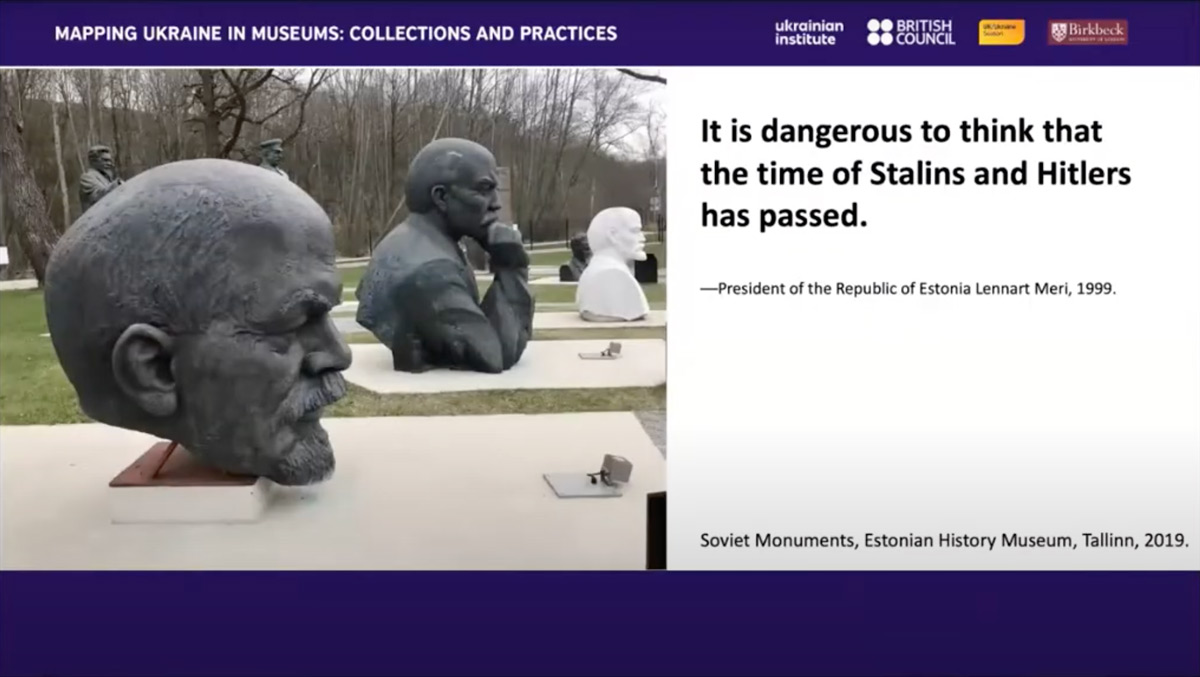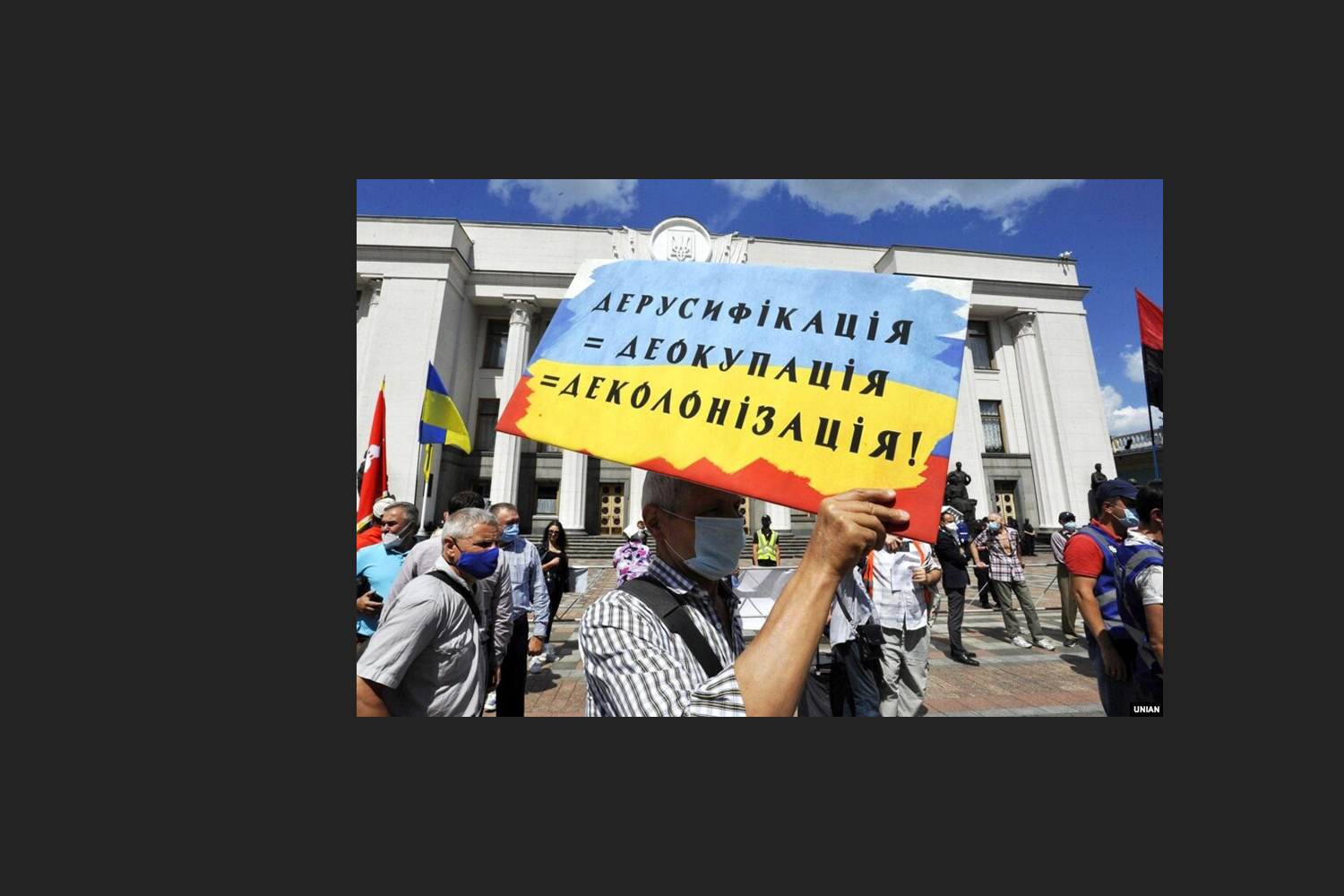* ESC - закрити вікно пошуку
DECOLONIZATION
Looking through the lens of decolonization: how should book museums change or how do we return book museums from “Russia’s captivity”?
06.09.2023
In the midst of the war’s acute phase, the Ukrainian cultural community has expanded the real battle against decolonization — almost at every event historians, culturologists, literature scholars and intellectuals rigorously critique the colonial lens through which many view Ukraine. Oksana Semenik, art historian, and her colleagues have raised the topic of the “return from Russian captivity” of Ukrainian artists’ names in museums and galleries worldwide, and consequently, discussions about the role of museums in the decolonization process are gaining strength. The two days online discussion “Mapping Ukraine in the Museum World: Collections and Practices”, organized by the Ukrainian Institute and the British Council in cooperation with Birkbeck University, was the most notable among them.
Chytomo decided to delve deeper into the topic and invited Valentyna Bochkovska, the Head of Museum of Books and Printing of Ukraine, to discuss and help us understand what is going on with the current state of book presentation in Ukraine and the world, and what must be done so that the concepts of the “three brotherly nations” and “enlightenment by printed word of Russia” ceased to appear in the descriptions of museum collections.
The project is supported by the British Council and the Ukrainian Institute as part of the framework of the UK/Ukraine Season of Culture.
Today in Ukraine, fewer than a dozen museums are directly dedicated to the history of books and printing in the country. These museums house unique collections: manuscripts from the 16th and 17th centuries, old prints by Ivan Fedorov, publications by European printing firms such as Aldii, Frobenius, Elzevier, Etienne, the works of Plato, Homer and Virgil in editions of the 16th century and even a unique collection of mini books. The Russian invasion has forced us to rethink the narratives that are presented not only in Ukrainian book museums but also worldwide. Furthermore, the Russian occupation has put the preservation of the collections of Ukrainian museums at risk.
The Museum of Miniature Books named after V. A. Razumov in Horlivka has a collection of 7,000 mini- and micro books from 59 countries written in 102 languages. It’s worth noting that it is the only museum in Ukraine with such a collection but it has been under occupation since 2014. Unfortunately, this collection is under threat of destruction now. We have already ample evidence indicating that the Russian occupiers deliberately sought out and destroyed Ukrainian books. “They burned books in the yards just like in the times of the Second Reich,” said Serhiy Haidai, the head of the Luhansk Regional Military Administration.
It’s also important to understand that historically , museums, especially book museums, have always been strictly controlled by the authorities since the Soviet times.
The Museum of Books and Printing of Ukraine in Kyiv, for example, has historically received particular attention from state authorities and the party. Scholars responsible for curating the exhibition in the 1970s were required to convey the official Soviet version of the history of books and printing in Ukraine, adhering closely to the grandiose official and ideological mythologies. The museum’s collection was initially curated and developed according to this narrative.
Until recently, the museum’s 16th-18th century section predominantly showcased Cyrillic books, which, undoubtedly, supported the myth of the unity of the three peoples — Russian, Belarusian and Ukrainian.
On the other hand, Ukrainian publishing centers that issued books in Polish, Latin, German, French or other languages were presented sporadically and without any system. The concept of Ukraine’s multiconfessional and multicultural history was not visualized in museum exhibitions, and so the history of Ukrainian identity formation, which had nothing to do with the concept of the “Russian world,” was greatly distorted.
Personally for me, decolonization began in the 1980s, when I first touched archive documents from the 16th and 17th centuries in the Central State Historical Archives, and heard a different history of Ukraine from archivists Viktor Strashko, Halyna Serhiichuk, Henadii Boryak, Natalia Yakovenko, Ihor Hirych, Zoia Borysiuk and Iryna Tsiborovska.
RELATED: A guide to the history of oppression of the Ukrainian language
It was the history we wanted to know and yet it was forbidden. A special department (a subdivision of the KGB) worked in the archives, some of the collections were confidential. It was not easy for researchers to work, studying the early modern times wasn’t “comme il faut.” Other periods of Ukrainian history were censored as well. These were the topics that were supported for dissertations: revolutions of February and October 1917, the Bolshevik movement and peasant uprisings.

Image from Tehmina Goskar’s presentation, director and curator of the Curatorial Research Centre
A new starting point was the declaration of Ukraine’s independence in 1991. Such museum relics as Kyivan Rus — the cradle of three fraternal peoples, the kinship of the Ukrainian and Russian languages, the enslavement of the Ukrainian people by the Polish nobility and so on remained in the past. Ukrainian became the language of exhibitions and lectures, the expositions were supplemented by the topics of the Holodomor, the Dissident Movement, Samvydav, OUN-UPA (Ukrainian Insurgent Army), Russian censorship, Ukrainian nationhood, the Executed Renaissance, the Revolution of 2004, 2014, the 2014-2023 war and the Ukrainian diaspora.
RELATED: The law on decolonization in Ukraine came into force
New Ukrainian heroes, ones who had been forgotten or forbidden, appeared in museums’ exhibitions: Ivan Mazepa, Ukrainian military, politician and a leader who was the Hetman of Zaporizhian Sich, Georgy Narbut, Ukrainian graphic designer known for his stamps and illustrations in magazines and books, Symon Petliura, military and politician, Mykhailo Hrushevskyi, Ukrainian historian, politician, the Head of the Central Rada — revolutionary parliament in 1917-1918, Mykhailo Zerov, poet, translator, literary critic, Dmytro Dontsov, Ukrainian publisher, journalist and a writer, Vyacheslav Chornovil, Ukrainian politician and political prisoner of the USSR, Vasyl Stus, poet, translator, journalist and an active member of the Ukrainian dissident movement.

Museum practices have changed. We have learned to build a dialog with the visitor. However, it is obvious that the way to overcome colonial and postcolonial narratives is much more difficult than we could have imagined.
Peculiarity of colonialism in Ukraine is indeed special (the Polish-Lithuanian Commonwealth, Austro-Hungarian Empire, the Russian Empire, the Soviet Union) and requires a change in the conceptual approach to the interpretation of exhibitions and collections in museums, where we should reject not only the Russian colonial narrative but also the European one.

To solve this difficult task, it is necessary, first of all, to shift emphasis and look at the history of Ukraine in the context of global colonial and postcolonial history. This is exactly what Hanna Rudyk, a curator of Islamic arts at the The Bohdan and Varvara Khanenko National Museum of Arts, explains in the course of the discussion. This will not only allow us to understand our place on the historical world map but also to go beyond the decolonization struggle, and find allies among countries that might have had similar experiences.
Where do we start?
To start decolonization practice, it would be good to turn to the experience of European colleagues, for example, the book by Magdalena Wróblewska and Csilla Ariese, a kind of a toolkit “Practicing Decoloniality in Museums” (Amsterdam, 2020).
Additionally , it is worth researching the inquiries of international organizations, such as the Museums Association in Great Britain, and planning your activities in this direction. For example, one step could be to develop a Decolonization Guidance, as the Association of Museums in the UK has done, and as Tehmina Goskar describes in her speech.

As to objective evaluation of events, Ukrainians are still too close to the “tornado zone.” In addition, we have not yet completely shaken off the colonial chains of our aggressive and uncontrollable neighbor. Russia has not reflected on its past and has not learned the necessary historical lessons, and hasn’t overcome its imperial greatness complex. The extreme forms of violence and exploitation that the Russian people have produced over the centuries testify to their unique ability to return to the past. Comparing the backgrounds of the colonizing countries, we can clearly see that Russia is an example of a country that is the most backward and incapable of restructuring. It is naïve to expect that the experience of constructive dialogue between post-colonial countries, such as the UK and Egypt, on restitution issues can be useful or implemented between Russia and Ukraine. At the very least, this can only be considered in a very distant future.

The events of the full-scale invasion in Ukraine have undermined the foundations of many years of Slavic studies where the narratives offered by Russian scholars with whom European and American scholars have mostly been in solidarity have always been dominant.
Today, however, overcoming the cultural appropriation of Ukraine in the global cultural space is happening with seven-league boots. What seemed impossible and far-fetched yesterday is now being institutionalized.
Therefore, it is important to study the experience of our colleagues, while not forgetting that we face other existential challenges. Our otherness is not our separateness.
This publication is sponsored by the Chytomo’s Patreon community


